(City council, school board, planning commission, county commissioners – these groups and several others represent us. They do the day to day work of running our community. It is our responsibility to keep informed about their work so that we can help them represent us effectively. “Civic Insights” by Jeffrey Vitarius is a regular feature of Act Locally Waco. Its purpose is to help us understand decisions that shape our community so that we can participate effectively as informed, engaged residents of Waco. – ALW)

By Jeffrey Vitarius
We hope you all had a safe and enjoyable Thanksgiving and thought it might be good to start back up with a topic we find particularly interesting, bus rapid transit (BRT).
Next Thursday (December 10th, 2020) at 6:00 pm Waco Transit, the Waco Metropolitan Planning Organization (MPO), and AECOM Technical Services are hosting a virtual meeting to gather public input on station locations and designs for the BRT project. AECOM also recently provided updates to the City Council and MPO on the progress of the project. Let’s take a look at why this project is being considered and what stage of the process we are in now.
Way back in 2013-4, the City of Waco commissioned an Economic Development Strategic Plan from the W.E. Upjohn Institute for Employment Research. The study is generally called the Upjohn Report. Unlike a standard economic development strategy that focuses purely on the “general economic performance of the area,” the City “called for a plan to also reduce poverty, increase labor force participation, and increase area income.” That is, rather than focus on economic growth in and of itself, the plan also focused on how that growth might be made equitable for the people of Waco. This focus on equitable development rather than just any development remains an important goal of the City.
In the process of drafting their report, the Upjohn team interviewed ninety individuals, asking them (in part) about what challenges they see to finding and retaining employment. The result, “transportation was overwhelmingly cited as the most prominent barrier to finding and keeping a job.” In 2018, about 8% of Wacoans got to work by a means other than a car. At that time approximately 29% of Wacoan households had no car or 1 car. The average household size in Waco is about 2.5 people meaning that having one car could mean a household is still reliant on a non-car means of getting to work.
Although walking or cycling remain valuable commuting options for folks (your author does so whenever he can), needing to rely on your feet or your bike makes you vulnerable to long distances and poor weather (especially August heat). Given these challenges, it is critical for those in Waco who do not have ready access to a car that public transit gets people where they need to go reliably and as swiftly as possible.
The current Waco transit system is configured as a “spoke and hub.” In this design bus routes extend out from the City core to residential neighborhoods, job centers, and service locations before returning Downtown. The routes out and back are the “spokes” with the Downtown Transit Center as the “hub.” The transit map below shows how the various routes converge at the transit center downtown before spanning out across the city.
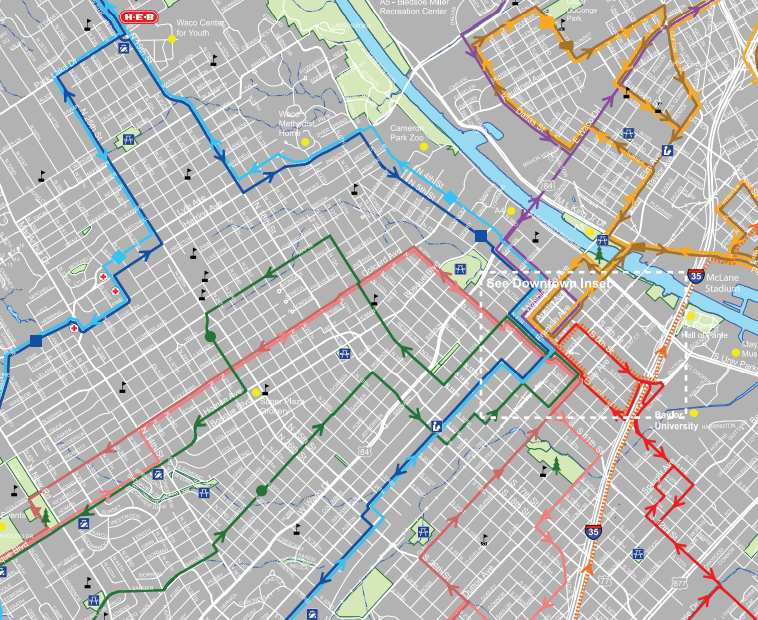
(Map 1)
This configuration has its challenges. The spoke and hub setup means that to get from one side of town to the other, an individual has to transfer at the “hub,” lengthening travel times. Additionally, the variety of routes mean that each route can only be run once an hour (in the case of East Waco the route runs varying directions based on what hour of the day it is).
BRT may be the solution to these issues. The BRT would run through the middle of the city extending from Woodway through Downtown Waco and on to Belmead and Lacy Lakeview. The BRT would make fewer stops and be timed to traffic. This would, theoretically, reduce the delays caused by passengers entering and exiting the bus as well as the delays caused by sitting in traffic. The goal of such a system would be to maximize the time the bus is in motion, therefore reducing travel times. It is also hoped that such a system would generate more frequent bus service and bus services that extend more into weekends and evenings (an important factor when considering whether folks can get to work when they need to).
In 2018, the City received a feasibility study from AECOM Technical Services that looked at the potential system overall as well as a number of route, technology, and service operation options. The study recommended (after substantial public input) a route that ran from US 84 to New Road to Franklin Avenue to Taylor Street and Hillsboro Drive before taking US 84 to Loop 340. On May 1, 2018 the City Council approved the recommended route. Below is the most recent map of the proposed route.

Since then, the City, the MPO, and AECOM have begun the process of seeking federal funding for the project. In July of 2019, pre-award authority was granted that allows the City to begin pursuing projected development costs before receiving a formal award. Under this authorization the City sought services for preliminary engineering and environmental review. We are in the middle of that process now.
Preliminary engineering (think of this as preliminary technical design) needs to be completed to understand the final costs of the project and pursue the funding needed to cover those costs. Environmental review is required to make sure the project will not unduly damage Waco’s environment. Throughout this part of the process there are three different periods of public input planned. The first passed in October, when AECOM sought to reintroduce the project to Wacoans and update them on the project approach. The second is the meeting coming up on December 10. This one will focus on where stations will be and how they will function. Both of these aspects can have a huge impact on cost and operations down the line. Finally, in mid-February it is anticipated that the final results for this phase of the project will be brought before the public for review.
Other Interesting Items from the Agenda (to me)
- Over the last two meetings City Council has received information regarding a Municipal Settings Designation (MSD). In short, this would reduce a hurdle to development in the city’s core by prohibiting the future use of groundwater as potable (safe to drink). Without a Municipal Settings Designation each property owner would have to deal with testing and remediating groundwater contamination before development which can slow projects in an area where the city provides water to all properties anyhow.
- The City and WISD are working on a partnership to provide all WISD students with e-cards that would grant them access to the library’s substantial e-book catalogue.
- The J.H. Hines Elementary Sidewalks project continues with the city pursuing $101,918.37 in property acquisitions to account for right of way needs.
Meeting Basics
- City Council meets on the first and third Tuesday of every month. Work session – 3:00 pm / Business session – 6:00pm (there have been two meetings since our last post)
- To watch the recorded session click here (City of Waco Cable Channel, wccc.tv)
- For the full agenda click here (11/17) or here (12/01)
- For the meeting packet with the documents pertinent to the meeting click here (11/17) or here (12/01)

Jeffrey Vitarius has been actively local since early 2017. He lives in Sanger Heights with partner (JD) and his son (Callahan). He helped found Waco Pride Network and spearheaded its Vision 2025 process. Jeffrey works at City Center Waco where he helps keep Downtown Waco clean, safe, and vibrant. He is a member of St. Alban’s Episcopal Church and graduated from Baylor in 2011.
The Act Locally Waco blog publishes posts with a connection to these aspirations for Waco. If you are interested in writing for the Act Locally Waco Blog, please email [email protected]for more information.
(City council, school board, planning commission, county commissioners – these groups and several others represent us. They do the day to day work of running our community. It is our responsibility to keep informed about their work so that we can help them represent us effectively. “Civic Insights” by Jeffrey Vitarius is a regular feature of Act Locally Waco. Its purpose is to help us understand decisions that shape our community so that we can participate effectively as informed, engaged residents of Waco. – ALW)

By Jeffrey Vitarius
On Tuesday November 10, 2020, the Budget & Audit committee of the City Council met. Their only discussion item was a review of the proposed Capital Improvements Program (CIP) and the associated debt impacts. Let’s breakdown what all this means and how it relates to the street in front of your house.
What is the Budget & Audit committee of the City Council?
This is the group of City Council members charged with taking a closer look at the city’s budget and audit functions.
So, is the Capital Improvements Program (CIP) a kind of budget?
Well, it is similar to one. Broadly speaking the city “budget” can be thought of as broken down into two parts, the operating budget and the CIP. The operating budget covers the services the city provides as well as its day-to-day work (we touched on an interesting summary of these services last week).The CIP covers large-scale projects. As this year’s budget explains “The CIP includes those items typically thought of as ‘infrastructure’ – streets, water and wastewater lines” (hmmm…streets, water, and wastewater sound familiar).
Since the CIP involves projects that span over multiple years, involve large dollar amounts, and often have a variety of funding sources (including debt) they are dealt with through a process separate from the operating budget.
Why is the CIP being dealt with now? Wasn’t the budget process in September?
In previous years, the CIP was developed at the same time as the operating budget (prior to September). This year, however, there was a change. The CIP process was moved to the winter after the budget process was concluded.
There were a number of reasons for the change, but two stand out. First, moving the CIP to its own time of the year allows staff and the City Council to focus on it alone in the winter rather than trying to split focus between developing the CIP and the operating budget. Second, moving the CIP to winter means that staff can work with certified property values.
As you may remember back when the Operating budget was adopted, the McLennan County Appraisal District was only able to issue a certified estimate of property values in Waco. At the time almost $1.8 billion dollars of value was still being protested (meaning it was still unclear exactly what those properties would be valued at and how much property tax revenue they would generate). The potential changes from the protest process make it difficult to build any kind of budget, but they are particularly problematic when you have to project a budget out for the multiple years required for CIP development.
So what does the CIP tell us?
In the broadest sense the CIP is a list of all the “infrastructure” projects the city plans to tackle during the year along with how it plans to pay for them.
What has happened so far in the process?
Back at its September 8th meeting the Budget and Audit Committee discussed the timeline change noted above. In October they held a preliminary discussion with staff regarding priorities. This week they reviewed the CIP drafted by staff in response to the discussion in October.
What is in this year’s proposed CIP?
Details of the proposed CIP can be found in the meeting packet for this week’s Budget and Audit Committee meeting. From a high level this CIP proposes $112,879,149 of capital spending in fiscal year 2021. $31,635,519 is planned for streets (see map below), $1,050,000 for park development, $6,150,000 for solid waste, $7,595,000 for airport improvements (mostly funded by CARES act funding), and finally $66,448,630 for utilities (water and wastewater).

The other critical part of the CIP is how all these projects are to be funded. A substantial part of the costs listed above are planned to be covered by the issuance of new debt (approximately 71%). The City staff is aiming to issue this debt in early 2021 (how the City issues debt is an interesting topic for a different time).
One last interesting take away from the proposed CIP is the chart below. It references a measure called PCI. This stands for pavement condition index. In short this is a metric for measuring the quality of streets. It runs from 0 to 100. This chart compares spending on various kinds of roadwork to their PCI impact. Overall, the anticipated PCI change is 1.43 (including the natural decay of the existing inventory). This would move Waco from 49.3 to 50.73 (an improvement of 3%).

What comes next?
- December 15th – City Council plans to approve resolution related to the issuance of debt for capital projects
- February 2nd – City Council plans to approve final CIP
Meeting Basics
- Budget & Audit Committee Regular meeting – Tuesday, November 10, 2020, 1:30 pm
- To watch the recorded session click here (City of Waco Cable Channel on YouTube)
- For the full agenda click here
- For the meeting packet with the documents pertinent to the meeting click here.

Jeffrey Vitarius has been actively local since early 2017. He lives in Sanger Heights with partner (JD) and his son (Callahan). He helped found Waco Pride Network and spearheaded its Vision 2025 process. Jeffrey works at City Center Waco where he helps keep Downtown Waco clean, safe, and vibrant. He is a member of St. Alban’s Episcopal Church and graduated from Baylor in 2011.
The Act Locally Waco blog publishes posts with a connection to these aspirations for Waco. If you are interested in writing for the Act Locally Waco Blog, please email [email protected]for more information.
by Anna Dunbar
America Recycles Day (ARD) has its 23rd anniversary this year. What many don’t know is that ARD has its roots in Texas, central Texas in fact. Texas Recycles Day began in 1994 as the idea of two Texas Commission on Environmental Quality employees, Kevin Tuerff and Valerie Davis. I had met them while I was at the agency and was always so impressed with their creativity. They came up with Texas Recycles Day to promote recycling on a day far enough away from Earth Day (April 22nd), but not before the Election Day in order to capture everyone’s attention. Thus November 15th was chosen as America Recycles Day!
Eventually, Texas Recycles Day was transformed into America Recycles Day. The first national America Recycles Day was held November 15th, 1997 and it has been celebrated annually ever since.
What about America Recycles Day in Waco? There is a lot of energy behind recycling in Waco. This year, the Waco Solid Waste Services is conducting a Scrap Tire Collection on Saturday, November 14. Here are the details:
- Location: 501 Schroeder Drive, near the Baylor Water Tower
- Hours: 7 AM until 12 Noon
- This event is for Waco residents only. Please pre-register or bring your Waco water utility bill as proof of residency.
- Restrictions:
- No more than 10 tires
- No tires from businesses
- No OTR, Skid Steer, Earth Movers
- Maximum size: 24 inches
- Maximum ten (10) tires per household
- Please preregister by calling (254) 299-2612
You might wonder why Waco Solid Waste Services is having a scrap tire collection at no extra charge. There are several reasons. First, recycling of scrap tires usually carries a fee per tire. The fee is waived during this event, making it easier for Wacoans to recycle their tires. Second, scrap tires are a breeding place for mosquitoes, which can carry diseases. Finally, scrap tires are prone to being dumped on vacant lots and other locations. This free collection is a good time to rid your property of scrap tires and recycle at the same time!
Waco Solid Waste Services encourages everyone to pre-register for this event and to wear a mask while talking with staff during the event. Pre-registration can be done by calling (254) 299-2612 Monday through Friday from 8 AM until 5 PM. Para informacion en Espanol: (254) 299-2612. There will also be a registration form at Waco-texas.com beginning November 5.
Thank you for keeping Waco Clean and Green!

Anna Dunbar is the solid waste administrator for the City of Waco Solid Waste Services. She is responsible for informing Waco residents and businesses about recycling and waste reduction opportunities as well as solid waste services in Waco. Her husband is a Baylor professor and her daughter is a Baylor University alum who works at Horizon Environmental Services, Inc. Anna is an active member of Keep Waco Beautiful and The Central Texas Audubon Society.
The Act Locally Waco blog publishes posts with a connection to these aspirations for Waco. If you are interested in writing for the Act Locally Waco Blog, please email [email protected] for more information.
(City council, school board, planning commission, county commissioners – these groups and several others represent us. They do the day to day work of running our community. It is our responsibility to keep informed about their work so that we can help them represent us effectively. “Civic Insights” by Jeffrey Vitarius is a regular feature of Act Locally Waco. Its purpose is to help us understand decisions that shape our community so that we can participate effectively as informed, engaged residents of Waco. – ALW)

By Jeffrey Vitarius
This week we are going to try to unpack the following item from the November 3, 2020 City Council Agenda: “Consider a resolution approving an agreement with WBW Single Development Group, LLC – Series 110 for an Annexation Service Plan for certain properties described as 61.51 acres of land, more or less, situated in and being out of the B.B.B. & C. Railroad Company Survey, Abstract No. 157, McLennan County, Texas, and being a part of the called 194.45 acre tract of land described in a Deed to WBW Single Land Investment, LLC – Series 104, recorded in Document No. 2019028303 of the Official Public Records of McLennan County, Texas, and being located near the intersection of Warren Road and Ritchie Road and further located within Waco’s extraterritorial jurisdiction, which said territory lies adjacent to and adjoins the present boundary limits of the City of Waco, Texas”.
Whew! This is a long one, let’s jump right in.
What kind of agreement is the City approving with WBW SIngle Development Group, LLC – Series 110?
On July 29th, 2020 WBW Single Development Group, LLC – Series 110 (lets just call them WBW for now) requested that the City annex certain property they own. Annexation is the process by which a city adds bits of land to its jurisdiction and begins to collect taxes from and provide services to those areas. There are a number of different ways annexation can occur. This week there are three instances of property owners requesting annexation on the City Council agenda. This process of a property owner requesting annexation from a city is managed by the Local Government Code (in particular Chapter 43 deals with annexations and subchapter C-3 deals with this specific kind of annexation).
The code requires that the property owner and city come to a written agreement regarding services, an “Annexation Service Plan.” Approving this agreement is the specific action City Council took this week.
What is an “Annexation Service Plan”?
Chapter 43 makes this one fairly simple. An Annexation Service Plan needs to list the services the municipality will provide and identify when it will provide them. The Annexation Service Plan for this item can be found in this week’s meeting packet (packet pages 124-7). The plan is actually a pretty interesting way to look at the bare bones of what the city does. Here is a list of the services the plan identifies:
- Police Protection
- Fire Protection and Emergency Medical Services
- Solid Waste Collection
- Water Service
- Waste Water Service
- Capital Improvements (building infrastructure for the most part)
- Street Lights
- Traffic Control (things like traffic signs, and stop lights)
- Maintenance of Existing Roads & Streets
- Environmental Services
- Maintenance of Parks & Recreation Facilities
- Maintenance of Publicly Owned Facility, Building or Municipal Service
- Provision of Other City Services (libraries, animal control, code enforcement, etc)
- Election Voting Services
This is almost a social contract in its most basic form. A property owner is agreeing to join the city and take on both the responsibility of paying its property taxes and abiding by its ordinances and the services the city agrees to provide. Additionally, this list makes clear just how often the citizens of Waco are impacted by the city. Driving to work involves city maintained roads and traffic signals. Watering lawns involve city water delivered through city pipes.
What does all that after “more or less, situated in” mean?
This section of the item lays out where the land being considered is located. The meeting packet includes a map as well (included below) on packet page 123, but this language is a general legal description of where the land is located. The item also includes a survey (on packet pages 130-1) that lays out even more detail regarding the exact parameters of the land being considered.
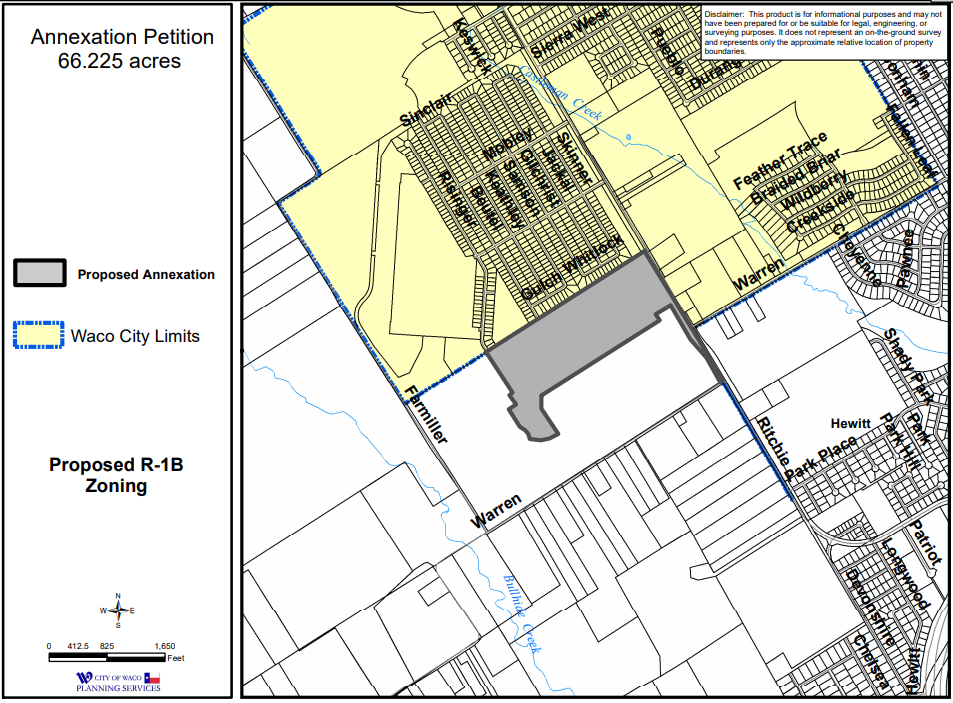
Why does the item mention Waco’s extraterritorial jurisdiction (ETJ)?
One of the requirements for annexation is that the land lay in the ETJ.
So, let’s go back to the initial sentence. We can now summarize it to mean: consider approving an agreement with a property owner to begin providing city services to a property described as x that is within Waco’s ETJ.
What comes next?
- November 17th – Public Hearing and First Reading/Vote
- December 1st – Second Reading/Vote
Other Interesting Items From the Agenda (to me)
- Impact fees are back for their second reading. There is also a work session item regarding how they could be changed in the future. This was one of the bigger questions Council member Holmes had two weeks ago.
- There are three Annexation Service Plans up for consideration. All in all they represent about 290 acres. The second and third of these plans are with the Waco Industrial Foundation which is an interesting topic for a different time.
- There are two resolutions and one ordinance related to Boards and Commissions. The resolutions are general and deal with approving appointments and clarifying certain language around advisory boards. The ordinance deals specifically with the Sustainable Resource Practices Advisory Board adjusting its mission, purpose, and membership.
Meeting Basics
- City Council meets on the first and third Tuesdays of every month.Work Session – 3:00 pm / Business Session – 6:00pm
- To watch the recorded session click here (City of Waco Cable Channel, wccc.tv)
- For the full agenda click here
- For the meeting packet with the documents pertinent to the meeting click here.

Jeffrey Vitarius has been actively local since early 2017. He lives in Sanger Heights with partner (JD) and his son (Callahan). He helped found Waco Pride Network and now serves as that organization’s treasurer and Pride Planning Chair. Jeffrey works at City Center Waco where he helps keep Downtown Waco clean, safe, and vibrant. He is a member of St. Alban’s Episcopal Church and graduated from Baylor in 2011.
The Act Locally Waco blog publishes posts with a connection to these aspirations for Waco. If you are interested in writing for the Act Locally Waco Blog, please email [email protected]for more information.
(City council, school board, planning commission, county commissioners – these groups and several others represent us. They do the day to day work of running our community. It is our responsibility to keep informed about their work so that we can help them represent us effectively. “Civic Insights” by Jeffrey Vitarius is a regular feature of Act Locally Waco. Its purpose is to help us understand decisions that shape our community so that we can participate effectively as informed, engaged residents of Waco. – ALW)
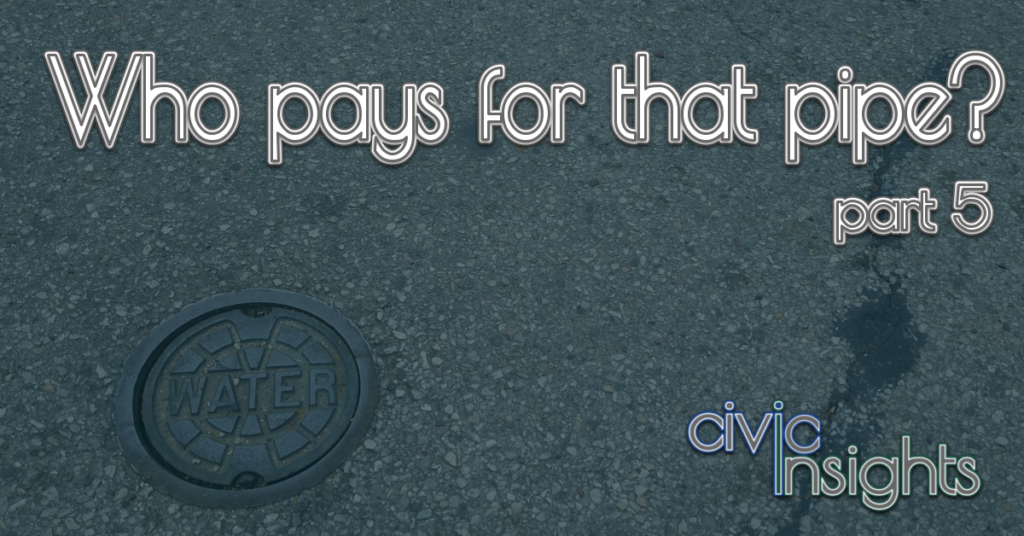
By Jeffrey Vitarius
We are finally coming to the end of the long impact fee process. This policy has been a goal of the city since it adopted the comprehensive twenty-five year plan in 2016. There has been intense study and discussion of the potential policy since Freese and Nichols (consulting firm) was hired to produce the study back in December of 2018. We have been writing about it here since early September. Last week, the City Council took its first vote on the initial policy that has been generated by this process. Another vote is scheduled for next Tuesday (November 6th) and this should be the final step.
Back in September, we started this discussion with a broad look at what an impact fee policy is. We moved from there to the legal process for establishing an impact fee, and finally to an examination of the pipe-related and road-related details of the Freese and Nichols report . That report will serve as the basis for any impact fee policy in Waco. Here in our final post, we will finally move from what impact fees could be to what they should be by examining the policy that was approved last week and the discussion that has occurred at the City Council level regarding how best to proceed.
The Policy
As a brief reminder, the Freese and Nichols report established the maximum allowable impact fees for water, wastewater, and roadways (the end of the could process). The results of that study are below.
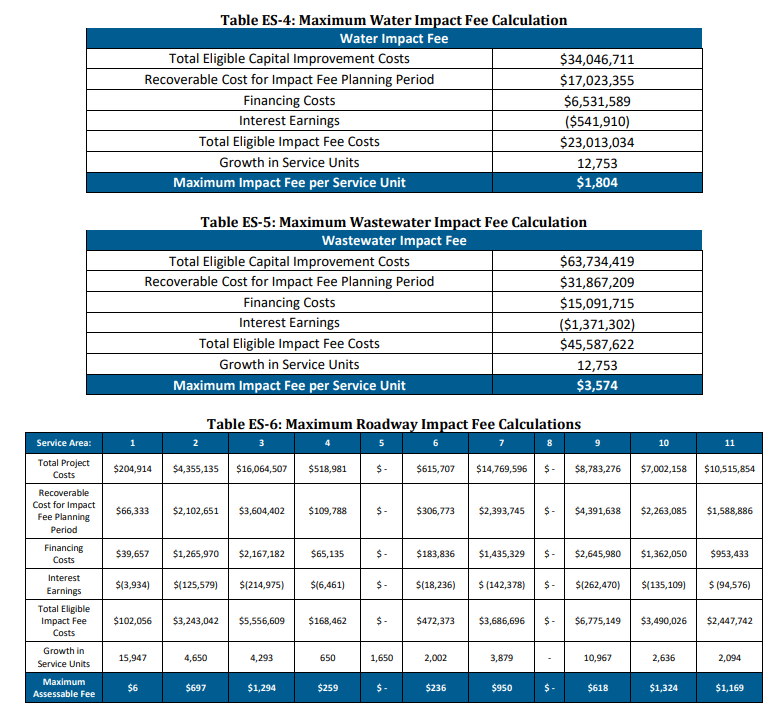
All of these maximums are based upon single-family home equivalency. So, the numbers above are the maximum allowable impact fees for a single-family home. For example, a single-family home in service area seven (near China Spring) could not have an impact fee above $6,328 ($1,804 – water + $3,574 – wastewater + $950 – roadway). Developments that are not made up of single-family homes have a maximum that is scaled based on calculations of use. So if a development is anticipated to use twice as much of the infrastructure as a single-family home, the maximum impact fee for that development is twice that of the single-family home (there is a lot more detail on this front in the last two posts).
The policy the city is in the process of adopting (found in more detailed form in the ordinance that was voted on last week) starts with base impact fees that are 100% of the allowable fees established above. However, to this base fee a number of exemptions, waivers, and limits are applied.
Below is a brief list of most but not all of these adjustments with some explanation of each:
- Residential Infill Waiver – single family homes in the “residential infill area” (map below) would have all impact fees waived
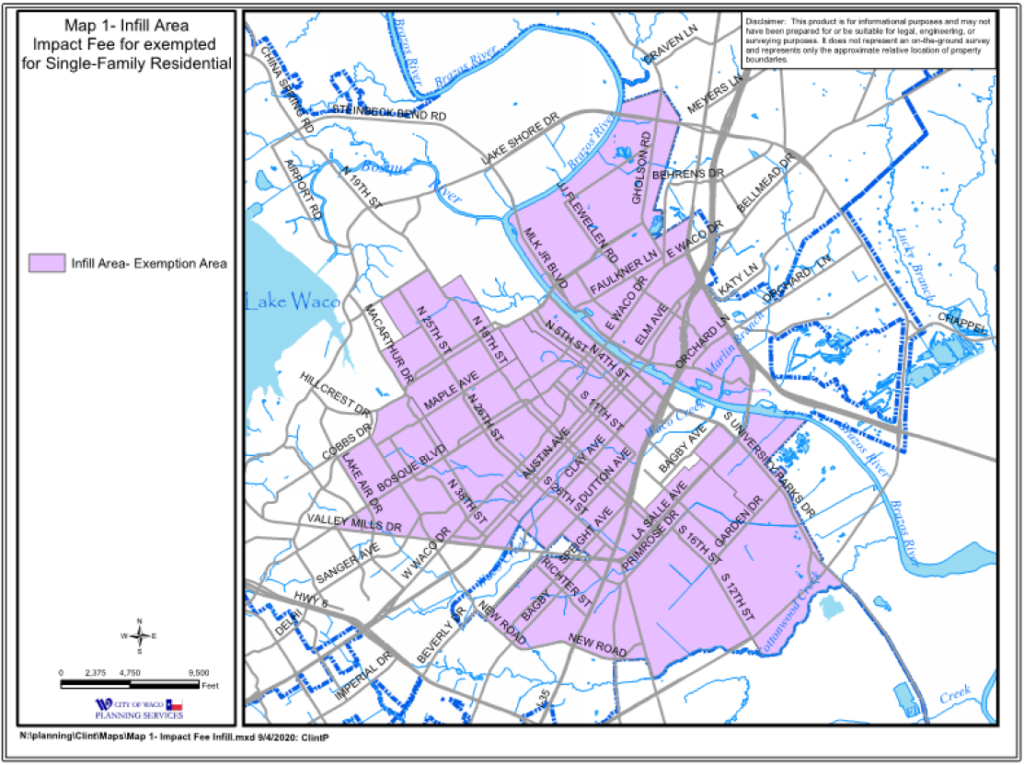
- Traditional Commercial Corridor Credit – non-single family home developments in the “traditional commercial corridor area” (map below) would have impact fees reduced by 50%
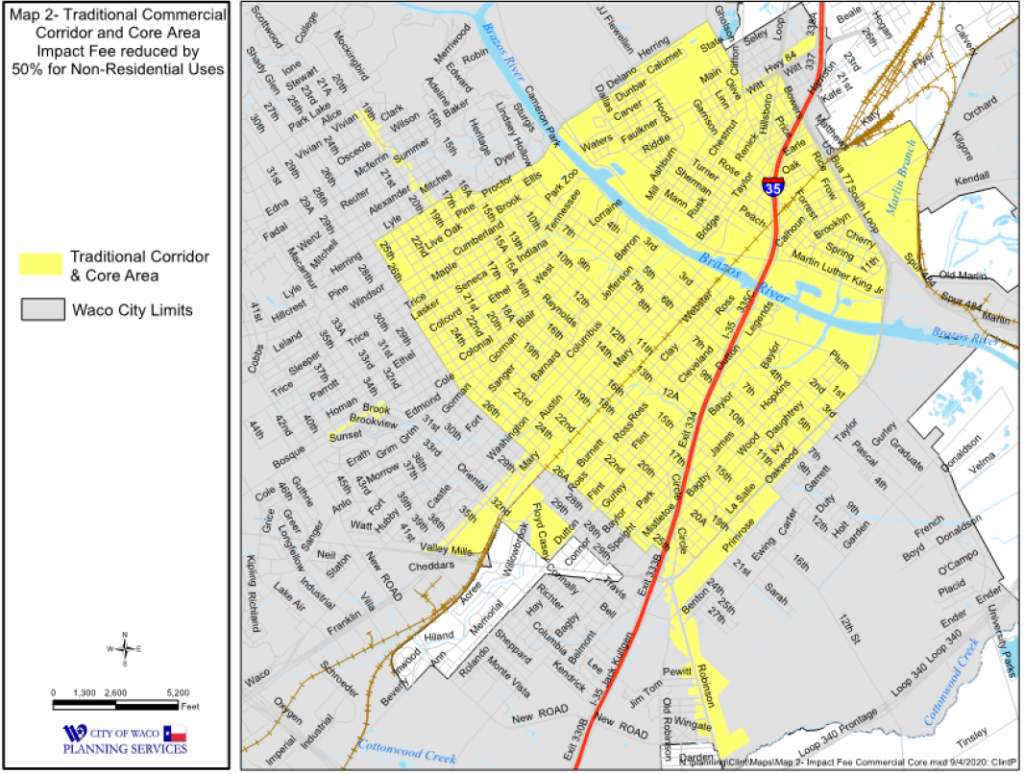
- Credits for construction of system-wide facilities – from a really broad view, if the development involves the construction of system-wide facilities (those kinds of infrastructure that are not just for the development itself) a credit to account for this construction would be applied to impact fees
- Affordable Housing Waiver – if a development has at least 25% affordable housing units (costing less than 30% of a household’s income for households making less than 80% of Waco’s median income) and an additional 25% that are either affordable or “workforce” units (costing less than 30% of a household’s income for households making between 80%-120% of Waco’s median income) impact fees would be waived. There are additional allowances for +sale units as well. Eagle eyed observers may spot that some of these percentages have appeared before in discussions of the CDBG program.
- Existing Business Waiver – if an existing business expands or relocates and the project fits with a collection of conditions (for example being open at least 2 years already, and documentations showing that the expansion or relocation will provide at least as many jobs as before) all impact fees would be waived.
- Phase-in elements – the policy has an effective date of June 1st, 2021. The fees would also be phased in over the course of five years (hitting 100% in June of 2024). There is also a waiver that would apply to projects that are nearly complete.
Each of these policy adjustments has some reasoning behind it and in most cases represents an effort to avoid disincentivizing certain kinds of development. It’s economics short-hand to say that if you make something more expensive you will get less of it (like most economics, I am sure there are disputes on this point, but the general rule remains). If affordable housing became more expensive to build due to impact fees, the theory goes that some number of units would not be built because of the increased cost. So, the above adjustments tend to exempt or reduce impact fees for the kinds of development that are high priorities for the city (infill residential, core commercial, affordable housing, etc). In addition to these adjustments, the policy gives the city the ability to grant waivers on a case by case basis as well.
The phase-in elements provide developers with some time to incorporate the new impact fees into their calculations and decision making.
The downside to these adjustments is that they make a complicated policy more complicated. Much of the discussion at City Council hit upon this point.
The Discussion
Over the course of the last two City Council meetings (10/06 and 10/20) there has been substantial discussion of the policy outlined above. In general, there has been support for impact fees in theory. Most points of concern have been focused on the specifics of the policy and its timeline for implementation.
The committee formed to analyze and make recommendations on the impact fee policy (the Capital Improvements Advisory Committee – CIAC) recommended the above policy with a single exception: that the implementation of commercial impact fees be delayed for six months (essentially pushing the effective date of commercial impact fees from June 1st, 2021 to December 1st, 2021).
This recommendation exception highlights one of the key elements of the discussion around this policy. The commercial impact fee calculation is substantially more complicated than the residential impact fee calculation. This makes sense, given the variety of developments that fit under the “commercial” umbrella. For commercial developments, the variety of kinds, sizes, locations, and exemptions all factor into the impact fee calculation. The city is working on a calculator to assist developers in navigating the detailed points of this part of the policy.
Additionally, concerns were focused on whether this policy strikes the right balance between funding the needed infrastructure projects and making sure not to disincentivize development. Since this policy is new, there were also questions about when and how it could be changed.
Input that was received from the public raised similar concerns and questions regarding balance and alternatives.
Arguments were made that the substantial phase-in elements of the policy and semi-annual review by the CIAC allowed for adjustment before the full impact of the fees would be felt by developers. Additionally, the importance of associating the costs of development with development rather than existing tax and ratepayers was emphasized. Ultimately the City Council voted 5-1 to approve the policy in its first vote. The Council will vote for a second and final time next Tuesday.
Thank you for walking through this review of impact fees with me. I hope to bring you something new or at least different in November. If there are any particular civic policy or issues you would like me to take more of a look at, please feel free to comment here. Thanks again.

Jeffrey Vitarius has been actively local since early 2017. He lives in Sanger Heights with partner (JD) and his son (Callahan). He helped found Waco Pride Network and now serves as that organization’s treasurer and Pride Planning Chair. Jeffrey works at City Center Waco where he helps keep Downtown Waco clean, safe, and vibrant. He is a member of St. Alban’s Episcopal Church and graduated from Baylor in 2011.
The Act Locally Waco blog publishes posts with a connection to these aspirations for Waco. If you are interested in writing for the Act Locally Waco Blog, please email [email protected]for more information.
(City council, school board, planning commission, county commissioners – these groups and several others represent us. They do the day to day work of running our community. It is our responsibility to keep informed about their work so that we can help them represent us effectively. “Civic Insights” by Jeffrey Vitarius is a regular feature of Act Locally Waco. Its purpose is to help us understand decisions that shape our community so that we can participate effectively as informed, engaged residents of Waco. – ALW)
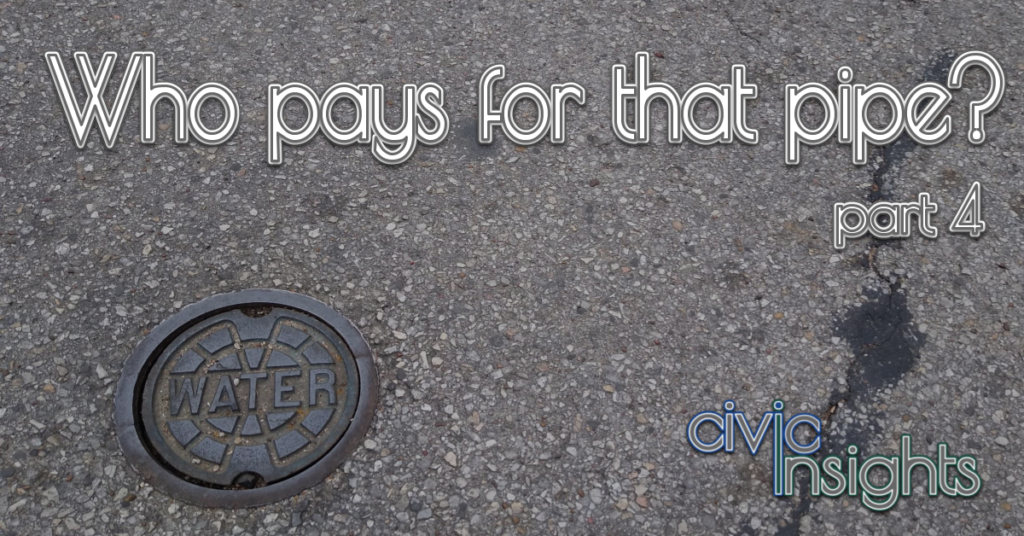
By Jeffrey Vitarius
Back in September, we began this series with a broad look at what an impact fee policy is. A month ago, we focused on the legal process for establishing an impact fee. Two weeks ago, we took a look at pipe-related details of the report that serves as the basis for any impact fee policy in Waco. This week, we’ll take a look at the road side of things. Then we will wrap up next week, by looking at the policy the City considered on October 20th.
As a bit of reminder, we are working our way through the following steps that were used to calculate maximum impact fees:
- Determine a service area
- Identify a way to connect demand for service to supply for service
- Calculate increased demand for services
- Review existing supply for services
- Determine and cost projects needed to meet increased demand
- Identify service unit to divide costs amongst projects
- Calculate maximum impact fees
1. Service Area
As you may recall from two weeks ago, service areas are the geographic boundaries of the impact fee policy. Chapter 395 provides guidance on what these areas can be or must be. For roads, there is a unique limitation that is not applied to pipes. Service areas for roads are limited to about twelve miles across (technically a six-mile radius). The reasoning here is that one part of town should not have to pay for the roads of a different part of town. For pipes the network is considered as a united system, whereas with roads smaller service areas are required. Additionally, a service area for roads cannot extend beyond the city limits (excluding the Extra-Terratorial Jurisdiction).
How these twelve mile “areas” are drawn is left up to the city or county looking to begin impact fees. For Waco the service areas ended up as this map:
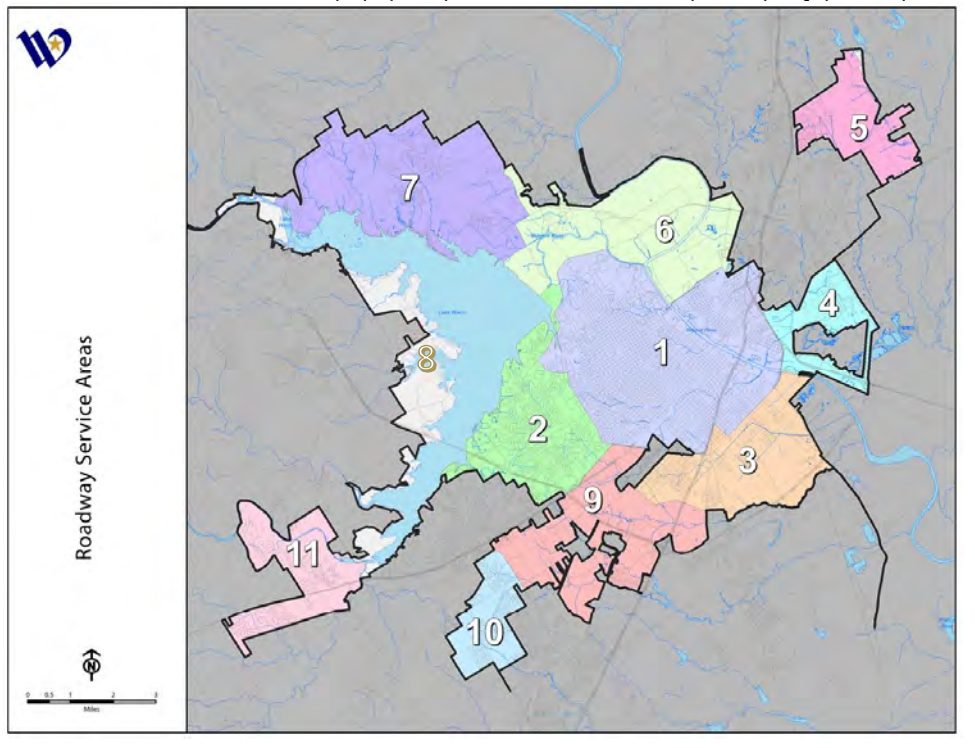
2. Connecting Demand and Supply
We will once again need to find some measurement to connect a new house or business park (demand) to the existing system of roads and any potential expansions (supply). The measurement needs to be scalable to the variety of demands that will come from new development and be measurable for distinct projects and supply systems. For roads, that measure is vehicle-mile at the PM peak hour. That probably needs some unpacking.
In thinking about the kind of measure we need here, the first impulse might be to simply count the cars. How many vehicles use the road system at any given point in time? That would get us part of the way there, but would miss a critical question: how far are those cars going? A car going a couple miles to a local restaurant “uses” substantially less roadway than a car going ten miles to work.
So we need to know not only how many cars are out there, but how far all of them are going. That is how we get to vehicle-miles. Ten cars going one mile has the same “vehicle miles” as one care going ten miles (10 cars x 1 mile = 10 vehicle-miles vs 1 car x 10 miles = 10 vehicle-miles).
On top of this, roadway use changes throughout the day, much like pipes (diurnal patterns). Road use peaks in the AM and the PM rush hours with less use in between. So, for the sake of impact fees the PM peak hour is used to measure vehicle-miles.
3. Increased Demand
Projecting how much Waco will grow overall, and where that growth will occur follows the exact same pattern that was used for pipes. For roads, however, a simple breakdown between growth in residents and employees will not be enough to fully capture the impact on roadways. For roads, the kind of employment becomes important.
We can see this if we think about the differences between a small industrial center and a retail park. Both may hire the same number of employees, but they generate substantially different vehicle-miles. At the industrial center, employees arrive and leave plus the occasional shipment of goods. However, at the retail center not only do you have employees and shipments coming and going, you also have customers.
To account for this our consultants, Freese and Nichols, broke employment growth down into basic, retail, and service categories. Each of these have a different impact on vehicle-miles. They then translated the number of new employees into anticipated square feet of use and bridged from that measure into vehicle-miles. For new residents, they looked at growth on a residences (rather than residents) basis.
Combining all this together they were able to project increased vehicle-mile demand for each of the service areas over the next ten years.
4. Existing Supply and 5. New Projects
A factor of particular importance in looking at how the current roadways will be able to accommodate the increased pressures of growth is how much are they currently being used. Pipes are metered. Water users are billed based on how much demand they put on the current systems. So it is fairly simple to gather information about current use. Roads are different. Their use is not tracked nearly as closely. For the sake of this study, Freese and Nichols relied on traffic counts that were collected on thirty separate locations across the city in May of 2019.
They then compared these counts to the traffic capacity of various road segments (think of these as the bits of road where the road stays the same, so the part of x drive that has four lanes is separated from the part that has two lanes). Capacity can normally be determined by looking at the design of the road. On a really rough level, you can see that I-35 has more capacity than Waco Drive which has more capacity than 10th Street. So looking at the current use and the design capacity of each roadway you can figure how many additional vehicle miles you can add in without needing to change the road (incidentally there are some roads that are already used more than their capacity, these “deficits” are ultimately taken out of the calculation of improvement cost since they are not a result of new demand).
Much like with pipes, Freese and Nichols along with City Staff then identified a number of improvements that might be eligible for impact fee funding. Unlike pipes, these projects were assigned to specific service areas. Where a project crossed the boundary between two service areas, its costs were split between the two. These projects were then examined for the amount of vehicle-mile capacity they added to the service area. So long as this added capacity was less than the increased demand in that service area (see step 3) the entire cost of the projects for that area could be included in the impact fee calculation. Where the added capacity was more than the increased demand, only that portion of the projects that covered the increased demand could be considered.
Combining all the allowable costs together, the report then applies the same 50% credit to the costs that we discussed with pipes. At the end of this process we have the total eligible impact fee cost – the total cost of increased capacity due to new demand after consideration of a credit for future taxes for each service area.
6. Service Unit
Chapter 395 calls for the establishment of a service unit specifically. It defines this (in broad terms) as a standardized measure of use. Although vehicle-miles remain a good connector between supply and demand, it is difficult to determine the exact number of vehicle-miles any given development would generate. So, the study scales vehicle-miles on the basis of a single-family residence. Basically, we look at each development in terms of how it relates to the demand generated by a single-family residence.
As was mentioned above, in general you can calculate the vehicle-miles produced by any given development based on its characteristics. We look at this in terms ultimately of trip total trip length. That is the number of vehicle-miles generated by the development. There are a number of interesting factors that go into this calculation (like trip generation, individual trip length, adjustments for diverted trips and local conditions), but we don’t have the space to get into all of these here. Instead we can go with a nice round number example. Let’s assume a single-family residence produces 4 miles of adjusted trip length and a retail store produces 12. The retail store will be scaled so that it can be measured as a multiple of a single family residence. With this example that multiple is 3 (12 divided by 4).
Here are some of the real ratios to give you an idea of how they work in the study. A hospital is anticipated to generate 1.72 times the demand of a single-family residence for every 1,000 square feet it contains. A clinic, in contrast, generates 5.81 times the demand of a single-family residence for every 1,000 square feet. These ratios allow for the generation of a comprehensible unit of measure to distribute the costs of the improvements.
7. Maximum Impact Fee
Knowing our service unit and our total eligible costs, the final step can be taken. A projection is made of the total new service units anticipated by development (for roads this projection relies heavily on land use assumptions since different kinds of development vary greatly in terms of trip generation). This projection is made on the basis of the service areas we noted above. For example, service area five as zero anticipated growth in service units. Whereas, service area one anticipates 15,947 new single-family resident equivalents. The chart below completes the process.
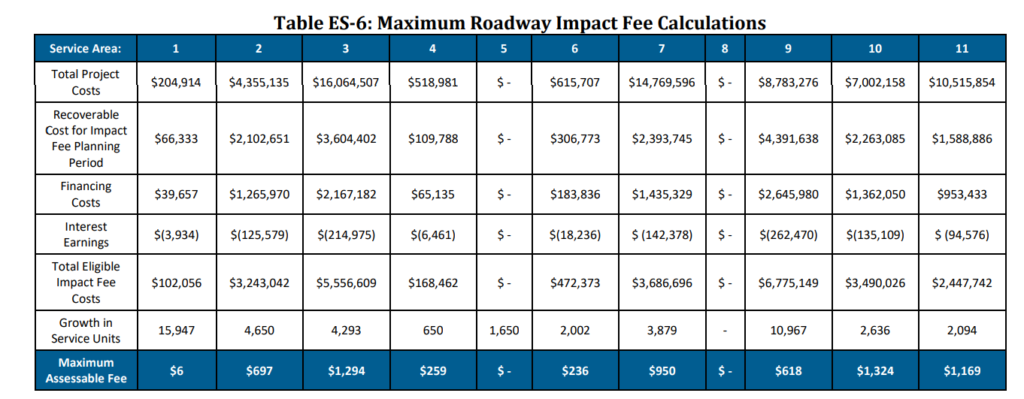
Here we see that after all these steps the maximum impact fee allowable by law for roads in service area one is $6 and for service area eleven is $1,169. These numbers are the final product of that could process we discussed at the very beginning of all of this. That is the process to determine what impact fees could be (as opposed to should be). Whatever the outcome of the should process is, the impact fees cannot exceed these amounts for a single-family residence equivalent.

Jeffrey Vitarius has been actively local since early 2017. He lives in Sanger Heights with partner (JD) and his son (Callahan). He helped found Waco Pride Network and now serves as that organization’s treasurer and Pride Planning Chair. Jeffrey works at City Center Waco where he helps keep Downtown Waco clean, safe, and vibrant. He is a member of St. Alban’s Episcopal Church and graduated from Baylor in 2011.
The Act Locally Waco blog publishes posts with a connection to these aspirations for Waco. If you are interested in writing for the Act Locally Waco Blog, please email [email protected]for more information.
By Kelly Palmer
Affordable housing, economic development, and COVID-19 are three of the most pressing issues our District IV City Councilmember must prioritize. More than ever, we need trustworthy leaders who listen to their constituents’ needs and are well equipped to address the complex issues our city faces.
Issue 1: Affordable Housing
The rising cost of housing in our community is one of the concerns I have heard repeatedly voiced by District IV residents. Since 2015, the cost of property taxes and housing in Waco has skyrocketed while wages have mostly stayed stagnate. Nearly half of our city’s residents are “housing burdened” and spend more than 30% of their monthly income on housing. As housing costs continue to surge, folks have to move further and further from the city’s core, where many of Waco’s highest paying jobs are located. Housing is an issue where we see poverty and race significantly intersect, in everything from disproportionate homeownership rates to redlining in communities of color.
While there are several ways to address housing-related issues, I believe we will not see meaningful change enacted until housing is a priority in our city’s budget — which ultimately reflects the city’s values. In reviewing the city of Waco’s budget from the past three fiscal years, I was surprised to learn that housing and community development are consistently the least funded budget category. Year after year, housing has made up only 1% of the city’s annual budget. By allocating greater resources to housing, we can invest in solutions that will help alleviate this significant area of need in our community. If elected to the council, I would advocate for both for the development of mixed-income housing, which the data suggests can significantly benefit both communities and residents, in addition to pursuing policies that prevent gentrification and displacement of families from generational homes.
Issue 2: Equitable Development
Waco has experienced a significant economic boom over the past several years, and yet, 44% of District IV residents make under $25,000 a year. While Waco’s growth has undoubtedly benefited some segments of our community, many of our neighbors have not shared in the prosperity or growth. As the city continues to expand in the coming years, the development we pursue must be sustainable and rooted in equity.
Equitable Development is a framework that encompasses economic and community development goals, in which community members are actively engaged in the decision-making process. If elected, I would pursue economic development initiatives that seek to improve the quality of life for all Wacoans, focusing particularly on our residents experiencing financial insecurity. One way I will do this is by championing jobs that provide our residents with a living wage and supporting our local workforce development programs. Through my work with Communities In Schools, I have seen firsthand the impact that workforce development programming can have on someone’s life by equipping them with an employable skill set that opens the door to financial security.
I look forward to reinforcing partnerships like this within our city, bringing together schools, non-profit organizations, and businesses to train our residents with the specialized skill sets needed to access high paying jobs available within the Greater Waco area.
Issue 3: COVID-19 Management & Recovery
COVID-19 continues to pose a real threat to the security and wellbeing of our community. While the virus has had broad sweeping adverse effects on all of our residents, it has significantly hit our communities of color. Our Black and Latinx populations have been disproportionately affected by COVID-19, as evidenced by the positivity and morbidity rates among these demographic groups. Addressing racial disparity as it relates to the novel-coronavirus is an issue of critical importance.
While there are no quick fixes or easy answers, our city council members must continue to provide thoughtful leadership throughout the duration of this crisis. Getting up-to-date, accurate information to our residents will continue to be an important area of focus. Finding ways to access hard-to-reach populations and populations at heightened risk of contracting the virus is also vital. We need city leaders who can strategically mitigate and respond to the wide range of effects COVID-19 has on our community. Even after a vaccine has been created and widely distributed, we will likely face the virus’s ramifications for months, if not years to come. As a city, we must be thoughtful as we develop plans for the long-term multi-tiered recovery we will need.
I commend Mayor Deaver, Judge Felton, and our extensive network of local healthcare providers for the decisive actions taken since March to flatten the curve and minimize the transmission of COVID-19 in our community. The road ahead of us is long, but we can weather the storms of this virus together. My experience working on the frontlines of a humanitarian aid crisis in 2015 and 2016 has equipped me with the skills needed to effectively prioritize competing values and lead during times of collective crisis.
2020 has been a challenging year, but there is hope for a brighter tomorrow. Our community is resilient and resourceful; we will get through this together. Collectively we can build a healthy future for all Wacoans – one where our neighbors have access to needed resources, our local economy is strong, and our community thrives. As a social worker and educator, I have the tools and expertise necessary to get us there. I have been on the frontlines, showing up for our community for years, and I’m ready to serve District IV residents as their next city councilwoman.
Biographical information for Kelly Palmer
Kelly Palmer is a licensed social worker and educator running for Waco City Council, District IV. She has called Waco home since 2013, when she moved to here to pursue her Masters in Social Work for Baylor University. Kelly is running for public office to further serve the community she loves by promoting greater equity and justice through public policy and city funding. Kelly’s campaign priorities are housing, COVID-19 leadership, and economic development with a focus on impacting our most financially insecure neighbors. When she’s not working, you can usually find Kelly volunteering with a local non-profit, on a walk with her husband, or nose deep in a book from the library.
NEWS RELEASE from the City of Waco
City Manager Bradley Ford announced Tuesday during the City Council work session several upcoming changes to his administration and city department changes. These changes are being made to align the organization to achieve the City Council’s newly identified strategic goals, which are:
· Build a High Performing City Government
· Create a Culture of Equity
· Enhance Quality of Life
· Facilitate Economic Development
· Improve Infrastructure
· Provide a Safe and Vibrant City
· Support Sustainability and Resiliency
A summary of the organizational changes includes:
— Deidra Emerson, who currently serves as an assistant city manager, will be promoted to deputy city manager. Deidra brings more than 25 years of experience in city government, including the last five years in Waco. She is a trusted adviser to City Manager Ford and will lead several key areas, including the city’s work on equitable practices, process improvement, and economic development.
— Melett Harrison, who currently leads economic development efforts for the city, will assume the newly created role of director of neighborhood engagement. Ford made re-energizing of the neighborhood program a key element of the upcoming budget, and Melett’s knowledge of various city departments will allow the city to move ahead quickly and strategically on this priority. Melett has served the City of Waco for more than 20 years in a variety of roles including housing, economic development, and neighborhoods.
— Ashley Nystrom, who is currently executive coordinator, will assume the newly created role of chief of staff to the city manager. Ashley has served the city for seven years. The chief of staff role will support the city manager by leading governmental relations functions, as well as serving as a key communicator to link the City Manager’s Office to
the broader city organization.
— Galen Price, who is currently director of housing and code enforcement, will temporarily assume the role of interim assistant city manager to support the re-alignment of various city departments until the city completes the recruitment for a third assistant city manager later in 2020.
Ford is quoted as saying, “The updated organizational structure at
City Hall will better align staff to meet the needs of our citizens and to achieve the strategic goals of the City Council.”
By Mayor Kyle Deaver
The brutal killing of George Floyd on Memorial Day at the hands of Minneapolis police was tragic, despicable, and completely unacceptable to our society. Unfortunately, it is part of a long history of the lack of equity in our nation. Waco has its own sad history of racism, including the lynching of Jesse Washington on May 15, 1916.
We have begun to face this reality in our community, and we must continue to move toward a more racially equitable society. The peaceful protestors and demonstrators who spoke and marched together this past Saturday in Waco were right in their calls for action. We must continue to work toward this future together.
Across the country, peaceful protestors and demonstrators have voiced this same desire. Unfortunately, in many cities, protests have involved looting and vandalism. That’s a terrible situation for many reasons. It is obviously unfair to those whose businesses and property are affected. It puts fellow protesters and police in danger, and it warps the message of the need to end racism in our nation. This jeopardizes that very message that so desperately needs to be heard, and it causes many of the people who need to hear and engage on this important message to, instead, become fearful and angry.
I want to thank the organizers and all who participated in last Saturday’s protests and demonstrations for their thoughtful, genuine approach to the problem of racial inequity and violence by some police officers. It is certainly not all, but it’s also not just “a few bad apples.” I also want to thank the leaders in our communities of color for their wise approach to these difficult times. And I want to thank them for relationships they have built with our police force.
I respect and admire every member of Waco’s Police Department that I have had the opportunity to get to know. I believe that each of them are every bit as sickened by what transpired in Minneapolis as I am. Police brutality anywhere in our nation strains the relationship between our citizens and the police who are doing their important and often dangerous work as they try to protect all of us.
Let’s continue to work together toward healing and racial equity. That will require difficult conversations about next steps. Those conversations have to occur.
Kyle Deaver was elected mayor in 2016 and was unopposed in 2018. He previously served four years on the Waco City Council as the representative for District V. Kyle is an attorney and businessman who is active in the Waco community. Deaver is currently on the board of the Waco Foundation. He has served on the boards of the Cameron Park Zoological Society, Greater Waco Chamber of Commerce, Vanguard College Preparatory School, and St. Paul’s Episcopal Day School. He served six years on the Waco Plan Commission.
- « Previous
- 1
- 2
- 3
- 4
